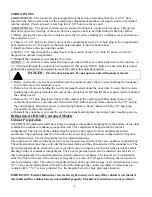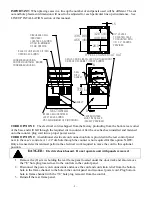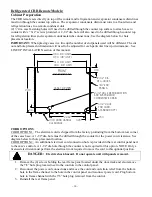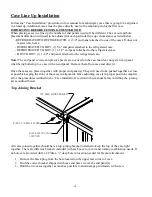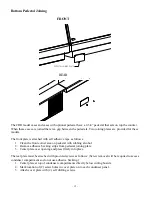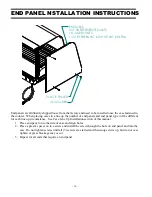
- 6 -
1.
Remove crate top and sides and note missing or damaged items as explained in the pre-installation
procedures outlined above.
2.
Move the case as near as possible to the final location and before removing it from the shipping skid.
3.
Remove the (4) brackets that secure the case to the shipping skid.
4.
Prepare cabinet according to instructions in this section that pertain to your model.
5.
Lift the case off of skid and into required position. Only lift the case from the frame channels located on
each end of the case
6.
Fasten each case to cabinet with the (4) #12 screws supplied.
7.
Route electrical cord according to instructions in this section that pertain to your model.
C
ase must be sealed to the counter using a NSF listed sealant.
8.
Install end panels.
Cleaning
For initial setup, clean the case as outlined in the “Weekly Cleaning” section of this manual.
Dry CD Model Installation
Cabinet Preparation
The CD models require (2) ½”dia. case fastening holes to be drilled through the counter top surface to
attach case to counter. Use the diagram below for hole placement location.
IMPORTANT:
When placing cases in a line up the number of end panels used will be different. The cut
out and hole placement dimension will need to be adjusted for each particular line up circumstance. See
LINE UPS INTALLATION section of this manual.
CUSTOMER SIDE
1/4" END
PANELS
(2) 1/2" DIA
MTG. HOLES
1-1/2" HOLE
FOR CORD
STANDARD OPT.1
11/16 DOOR HANDLE
CLEARANCE
1.53
2.76
3.03
35.0 (36" UNIT)
47.0 (48" UNIT)
31.0 (36" UNIT)
43.0 (48" UNIT)
FRONT
29.0
CASE TOP VIEW
CORD OPTIONS
CORD OPTION1: The electrical cord is shipped from the factory protruding from the bottom rear corner of
the cases base. A 1-1/2”dia. hole must be drilled through the counter for the power cord clearance. See
diagram below for hole placement location.
CORD OPTION 2:An additional electrical cord connection hole is provided in the rear control panel next
to the case’s controls. A 1-1/2”dia hole through the counter is not required for this option. NOTE: Only a
licensed electrician must perform the electrical work required to move the cord to this optional position.








